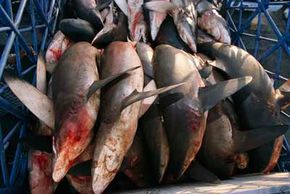With close to 400 shark species floating around, you could fill volumes cataloguing their individual food habits. While cookiecutter sharks take nonlethal bites of flesh from their prey and call it a day, great white sharks may eat large sea mammals in one big gulp. And certainly the dietary customs of the 8-inch (20-centimeter) dogfish shark vary from that of the 60-foot (20-meter) whale shark, not to mention the different cousins, aunts and uncles in between.
Advertisement
All sharks are at least partly carnivorous. They usually consume between 0.5 and 3.0 percent of their body weight each meal since most space their dinners out to every two or three days. Although their bodies are well equipped for catching food, they can't chew well, so they need time to properly digest [source: Cawardine].
Since sharks stand at the top of the aquatic food chain, their diets play an important role in regulating the species below them, much like lions in the jungle. For instance, if large sharks were to die out, that would increase the population of octopus, which in turn would feed on more lobsters [source: New York Times].
In addition, shark hunting habits help to perpetuate a survival of the fittest mode in their environment. To conserve energy, sharks often target weak, immature or sickly fish or mammals [source: Parker]. That weeds out the more vulnerable creatures and keeps the stronger, healthier fish and animals alive.
What fish and mammals in particular are sharks dining on? Find out on the next page.
Advertisement


